Stitch 'n Bitch: The Knitter's Handbook (47 page)
Read Stitch 'n Bitch: The Knitter's Handbook Online
Authors: Debbie Stoller

G
AUGE
22 sts and 28 rows = 4" in St st with MC
D
IRECTIONS
BACK
With MC, CO 102 (110, 118, 126) sts.
Work 84 (88, 92, 94) rows in St st—12 (12½, 13, 13½)".
BO 4 (5, 6, 7) sts at beg of next 2 rows.
Dec 1 st each side every 2nd row 5 (6, 8, 10) times—86 (88, 90, 92) sts.
Cont in St st for 140 (146, 154, 160) rows total—20 (21, 22, 23)".
BO all sts.
FRONT (MAKE TWO, REVERSING SHAPING)
With MC, CO 52 (56, 60, 64) sts.
Work 84 (88, 92, 94) rows in St st—12 (12½, 13, 13½)".
BO 4 (5, 6, 7) sts at side edge.
Dec 1 st at side edge every 2nd row 5 (6, 8, 10) times—43 (45, 46, 47) sts.
At the same time,
when piece meas 104 (112, 118, 126) rows total—15 (16, 17, 18)"—dec 1 st at neck edge every row 6 times; then every 2nd row 14 times—23 (25, 26, 27) sts. Cont in St st until front meas same as back. BO all sts.
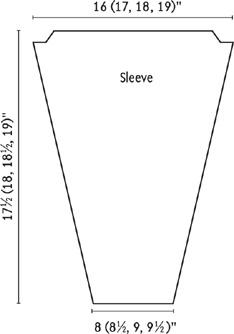

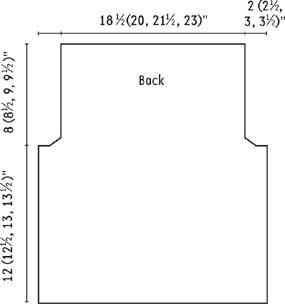
SLEEVES
With MC, CO 44 (48, 50, 52) sts.
Working in St st, inc 1 st each side every 5th row 0 (0, 8, 16) times, every 6th row 18 (20, 14, 8) times, then every 7th row 2 (0, 0, 0) times—82 (88, 94, 100) sts.
Cont in St st until piece meas 122 (126, 130, 134) rows total—17½ (18, 18½, 19)".
SHAPE SLEEVE CAP
BO 4 (5, 6, 7) sts at beg of next 2 rows. Dec 1 st each side, every 2nd row 5 (6, 8, 10) times. BO rem 64 (66, 66, 66) sts.
FINISHING
Sew shoulder seams. Sew sleeve caps into armholes. Sew side and sleeve seams.
TRIM
With 3 strands of CC held tog, sc evenly around entire edge of cardigan. Don’t match up st for st—the mohair
is going to be a way different gauge than the wool. Just do this by eye and feel to make it not too tight and not too loose.
BUTTONHOLE BANDS
Place markers on right front for 7 buttonholes, with first one at beg of neck shaping and last one ½" from bottom.
Now work a 2nd row of sc along the front edges for the buttonhole bands. When you get to a marker, ch 3, sk 1 st, then cont in sc to next marker. Fasten off after finishing the last buttonhole. Work a second row of sc on opposite side as well. Sew on buttons opposite buttonholes.
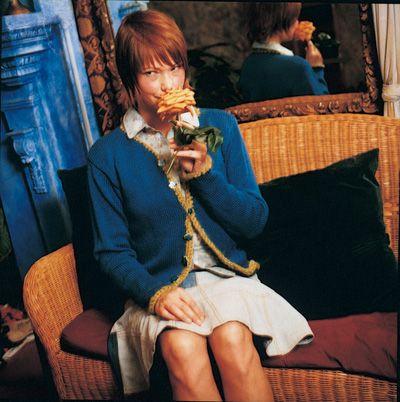
ABOUT LAURA JEAN

I started knitting in October 1994, and within two weeks I had sold my first sweater. I had so many ideas, I just kept making sweaters. People would stop me on the street and ask me where I got what I was wearing. Desperate for something I could call a career, I decided to start my own business. That’s how Fresh Baked Goods was born. The business was small at first, based out of my living room, but today I have my own shop in Toronto, and a Web site (
www.freshbakedgoods.com
), where I sell all of my knit projects.
I’ll admit that I’m a bit results-oriented, which is why I love machine knitting—I can actually get things done before I’m bored with them, and for the business side of things, it’s a necessity. That said, I also love the relaxed pace of hand knitting. It’s amazing to watch my two hands, needles, and time turn a simple bit of yarn into a wearable item.
MARTHA LAZAR
I designed this sweater at the end of a long, cold winter. I’d been suffering from cabin fever and was already thinking about spring, which is why I knit the mohair in a very open, airy gauge. The shaping was inspired by some beautiful Tibetan silk tunics that I was longing to wear as soon as it warmed up.
The yarn for the sweater was dyed with Kool-Aid. Why? Well, it’s easy, fun, nontoxic, and you get the most amazing range of colors. Our Kool-Aid classes at Urban Knitter are always fun, and people come up with the greatest color combinations. I chose sedate colors for this project to show that you can get pretty sophisticated with Kool-Aid, but you can go wild, too. There’s a whole range of colors, from flaming red to toilet-bowl-cleanser blue. Play around with a few test hanks, or dive in with your whole stash.
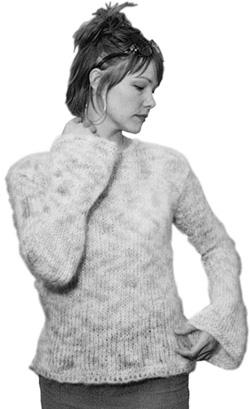
SKILLS | PAGE |
CAST ON | |
KNIT | |
PURL | |
DECREASE | |
BIND OFF | |
SEW SEAM | |
SINGLE CROCHET |
S
IZES
Small (Medium, Large, Extra-Large)
Finished bust: 38 (40, 43, 46)"
M
ATERIALS
Halcyon yarn
Victorian Brushed Mohair
(70% mohair/24% wool/6% nylon; 50g/145 yds)
4 (5, 5, 6) skeins #103
2 boxes Kool-Aid, Magic Secret and Changin’ Cherry
US 13 (9mm) knitting needles, or size needed to obtain gauge
H/8 crochet hook
G
AUGE
10 sts and 14 rows = 4" in St st
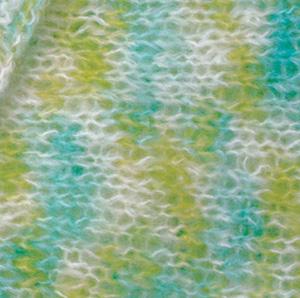
D
YEING
D
IRECTIONS
Kool-Aid will work only with animal fibers, so wool, mohair, angora, and silk work well, but cotton, linen, and rayon won’t hold the color.
The suggested starting point for mixing the colors is 1 packet of unsweetened Kool Aid mixed with 1 cup (8 oz.) of lukewarm water. (You’ll probably end up using about 3 packets of each color.)
You can add 1 oz. white vinegar to help with colorfastness, although some people feel this isn’t necessary, as the Kool-Aid contains citric acid. I suggest using clear measuring cups, so you’ll be able to see the color clearly.
You can mix different Kool-Aid colors like watercolors; add more water to make lighter colors, or more Kool-Aid for more saturated colors. The grape color is very intense and acts like a black. When you add a very diluted solution of grape to a primary red, you’ll get a raspberry color. Play around with the colors; perhaps even knit a swatch to see how the dyed yarn looks knit. If you are going to use more than 1 skein for a project, take notes about your color mixtures and dilutions so you can duplicate them.
1.
Wind your yarn into hanks (see
page 111
) if it doesn’t already come that way. Don’t try to dye a ball of yarn, because the middle won’t get the color. Try to make the hanks consistent if you are dyeing multiple skeins for a project.
2.
Loosely tie the hanks in at least 4 places so they don’t unwind and get tangled.